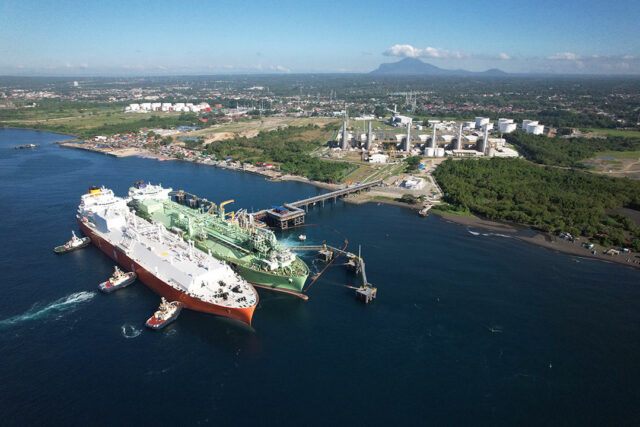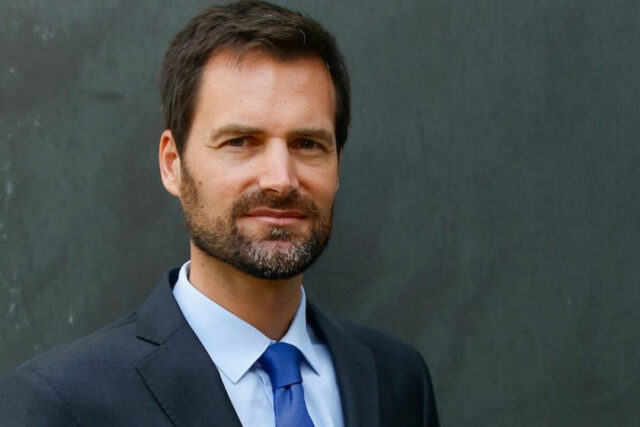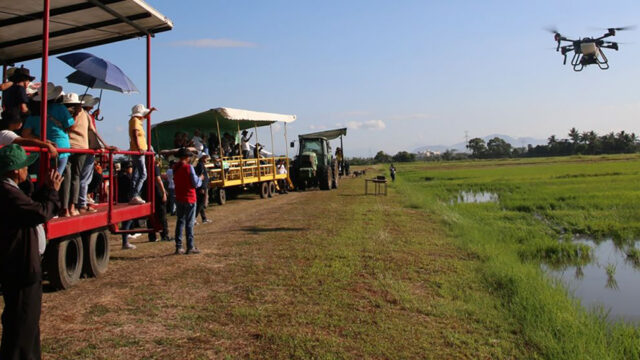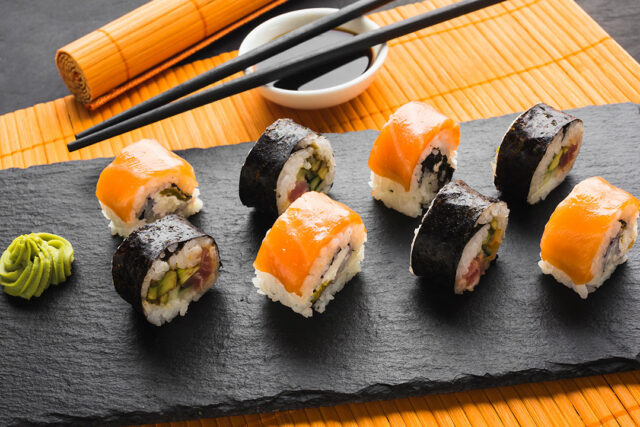By Kazunori Takada, Akemi Terukina and Kat Odell
JUST FIVE years ago, a US tourist visiting Japan would have paid a small fortune — close to $500 — for a ¥50,000 omakase meal at a high-end sushi counter in Tokyo. Today, the same meal will cost the visitor just a little over $300.
The notable price drop comes because of the weak yen, which has fallen around 30% against the dollar over the past five years and hit 38-year lows in July. With the lopsided exchange rate, even Tokyo’s most famous sushi restaurants now feel affordable.
At the same time, customers at top-of-the-line sushi counters in New York know it’s routine to spend $500 before they’ve even walked in the door, let alone left a tip.
The relative bargain of ordering sushi in Tokyo has not been lost on international food fans. Sushi restaurants in Tokyo have seen an influx of tourists, turning some of the oldest sushi restaurants into a melting pot. The number of visitors to Japan continues to reach record highs; in October 2024, 3.3 million people arrived in the country, according to the Japan National Tourism Organization. In fact, the stream of travelers spurred some restaurants in tourist-friendly destinations to implement a two-tier pricing system. At Tamatebako, the all-you-can-eat seafood spot in Shibuya, it’s ¥9,328 yen for female residents and ¥10,428 for female tourists. Men pay ¥500 more for their respective categories.
Another plus for sushi-seeking tourists in Tokyo is the plethora of affordable options. In Ginza, a three-minute walk from one of the city’s most renowned (and pricey) sushi restaurants, Sukiyabashi Jiro, there’s an outpost of the solid franchise Kura Sushi, which serves two pieces of sushi for ¥155, or $1 — the preferred price for most Japanese diners.
In New York, the cost of a sushi dinner continues to rise, in part because of pricey real estate, labor (the city’s minimum wage just went up to $16.50), and the increasing cost of shipping pristine seafood from the other side of the world. The price of eating out nationally was 3.6% higher in November 2024 than the previous year, according to the USDA. The tab for eating out at local sushi restaurants has risen more sharply in some spots. At Sushi Noz, the vaunted Upper East Side dining room, a meal is now $550 without tax, tip, or drinks; it’s a 10% increase from a year ago, when it was $500.
Over the past year, Icca in Tribeca has raised its omakase price from $400 to $495. (Gratuity is now included; the actual increase is around $15.) Chef Kazushige Suzuki attributes the rising costs to the global proliferation of high-end sushi counters, which has led to a decline in the availability of certain seafood such as bluefin tuna, which in turn spikes prices.
But there’s a silver lining for New Yorkers: The number of good midrange counters is climbing, too. That’s thanks to local operators including Linda Wang of the Ume Hospitality Group, whose 10 sushi counters typically offer 60-minute meals for around $75. Her model is built around buying seafood in bulk and turning over seats briskly.
Still, it’s hard to ignore the value you can find in Tokyo. For a head-to-head comparison, read on and see what $500 gets you for notably good sushi in both cities.
TOKYO
Sukiyabashi Jiro
$500 gets you: Dinner for one-and-a-half customers
If you didn’t know the name, you wouldn’t guess that Sukiyabashi Jiro is Tokyo’s most famous sushi restaurant. Located on the underground level of a 64-year-old commercial building in the central Ginza district, its shop front is very simple. But Jiro has served countless celebrities, notably former Prime Minister Shinzo Abe, who took Barack Obama there during the former US president’s 2014 visit.
The place adheres to the traditional Edomae style, when sushi was served as street stall fast food, so the menu is simple: just raw fish. Otsumami, or drink-friendly snacks, aren’t served. But it’s so popular that if you call to make a reservation, the automated message will tell you it’s fully booked. If you get seats, the 20-piece sushi dinner starts at ¥58,000.
Ginza Kyubey
$500 gets you: Dinner for two, almost
Opened in 1935, the restaurant has been favored by local power brokers including Shigeru Yoshida, the country’s prime minister following World War II. The ¥40,000 menu includes two appetizers, sashimi, yakimono (grilled fish), nimono (a stewed dish), and 11 pieces of sushi. A multilingual chef, possibly even owner Yosuke Imada, details the selections.
Ginza Kyubey has another claim to fame: The restaurant invented a major form of sushi known as “gunkan” (seafood and rice enclosed in a round nori band), after a customer from Hokkaido asked for his sea urchin to be made into sushi.
Shutoku
$500 gets you: Dinner for at least five
Shutoku roots go back to one of Tokyo’s oldest sushi restaurants, dating back some 400 years. It’s located up a flight of stairs in Tsukiji, which for centuries was home to the city’s main fish market and handled some of the most expensive fish shipped from across the country. (In 2018, the market relocated a few miles south to Toyosu.) A meal will cycle through a series of classics such as hirame (flounder), aji (horse mackerel), and ika (squid) dusted with a few sesame seeds; less common options like gizzard shad might show up, too. The chefs add a generous amount of red vinegar to the rice, a tradition that dates to the Edo period (from 1603 to the 1860s) and turns the rice a funky colored light brown. Omakase meals range from ¥7,000 to ¥15,000.
Kura Sushi Global Flagship Store, Ginza
$500 gets you: A meal for 30 or more
For something casual — and a place to entertain small children — Kura Sushi, a block away from Sukiyabashi Jiro in Ginza, is a super option. Unlike most sushi restaurants, check-in is at a machine at the entrance which allocates a table number. Once seated, pick plates of sushi circulating on a conveyor belt, such as toro or tamago (egg), or order via a tablet or your own smartphone, which gets delivered directly to your table via a separate fast-speed belt. After eating, diners can try their luck at roulette with toys as the prize. A two-piece plate of sushi starts at ¥150.
NEW YORK
Masa
$500 gets you: Half a Hinoki counter experience
Haute sushi pioneer Masa Takayama put luxe omakase dining on the map 20 years ago when his three-Michelin-star counter opened in what’s now known as the Deutsche Bank Center at Columbus Circle. The restaurant has continued to offer the city’s highest-priced sushi. Takayama has only one seasonal menu, with bites such as stone crab with uni aioli and his signature toro tartare crowned with osetra caviar. Those who sit at the roughly nine-seat Hinoki counter will spend $950 (excluding tax and tip); in the dining room, the same meal costs $200 less.
Sushi Noz
$500 gets you: Dinner for one, almost
The six-year-old, two-Michelin-star effort from chef Nozomu Abe and owner Joshua Foulquir is a shoebox-size space that holds two counters with a total of 14 seats. The menu runs $550 (including tip but not tax), punctuated by rare seafood that’s hard to find elsewhere in the city. The 20-course meal typically begins with five seasonal appetizers, followed by nigiri such as live scallop and baby sea bream, and concludes with a daily-changing miso soup, tamago, and two desserts.
Icca
$500 gets you: Dinner for one
Kazushige Suzuki, a veteran of the New York’s now-shuttered Sushi Ginza Onodera, now helms the three-year-old Icca’s subtly Italian-accented eight-seat Edomae-rooted counter. His 21-course omakase leans heavily into appetizers with dishes like Hokkaido hairy crab and uni pasta before moving into nigiri bites, plus tamago, miso soup, and Japanese crown melon mousse for dessert for $495 (including tip). The restaurant is also known for its exceptional sake program rife with rare bottles; pairings are $220 or $280.
Shota Omakase
$500 gets you: Dinner for two
Brooklyn isn’t known as a sushi destination, which is why Cheng Lin opened his spacious 18-seat counter on a residential stretch of South 3rd Street in Williamsburg in August 2023. In fact, Shota is one of the best sushi deals in town; Lin sources premium Japanese ingredients, from sawara (Spanish mackerel) to slippery mozuku seaweed, for his $195 omakase that blends Edomae simplicity with a little innovation. If you have a bigger budget, throw in an order of rare seasonal uni from Hokkaido and black truffles to top a yuzu-miso cod hand roll and other orders.
Omakase Room by Shin
$500 gets you: Dinner for two plus two glasses of sake
As one of the city’s newest sushi entrants, sleek Omakase Room by Shin (sibling to the West Village’s Omakase Room by Mitsu) falls in the modestly priced — by NYC standards — omakase camp. The $195 (exclusive of tax and tip) omakase spans 14 courses solely dedicated to nigiri built from peak seasonal seafood helmed by Blue Ribbon Sushi vet Shin Yamaoka. Expect fish like buttery ora king salmon and a three-bite tuna series — served on rice imbued with red vinegar laced with sake lees. The meal signs out with an uni hand roll, geoduck clam miso soup, and the chef’s signature spongy tamago. Drinks options at the 14-seat counter include smooth, elegant Hoyo Manamusume junmai sakes.
Hōseki
$500 gets you: Lunch for four
Hōseki, the boîte tucked behind a velvet curtain on the lower floor of tony Midtown department store Saks Fifth Avenue, delivers a 12-course menu for $95 in 60 minutes. Morgan Adamson runs the six-seat counter’s minimalist and Edomae-inspired show, which relies on a mix of domestic and Japanese seafood. Her meals begin with a seasonal soup such as kabocha squash and carrot, then move to an appetizer like sesame-dressed Hokkaido scallop with finger limes, nine nigiri bites with Hokkaido uni and local skate, and, finally, a bluefin hand roll with shiso. Adamson works with two distinctly seasoned rices: lighter fish paired with rice imbued with a bright vinegar; fattier fish are served with rice accented with a more complex vinegar.
Thirteen Water
$500 gets you: Dinner for four and a bottle of sake
Thirteen Water proprietor Linda Wang has garnered a following for her string of shockingly affordable omakase spots that scoot diners in and out within an hour. One is Thirteen Water in the East Village, and another is a new Hudson Yards outpost. The $75 omakase is served in a charcoal-hued space anchored by a 16-seat, U-shaped counter. Chef Aaron Liu preps a nontraditional, weekly-changing 13-course menu with global seafood via a quick succession of 12 nigiri — including chutoro (medium-fatty tuna) crowned with chopped chutoro, pickled wasabi, and wasabi soy sauce — and concluding with a maki roll. Because the high-umami meal is so affordable, you can still get a 720-milliliter bottle of Born Gold junmai sake for $78. — Bloomberg













